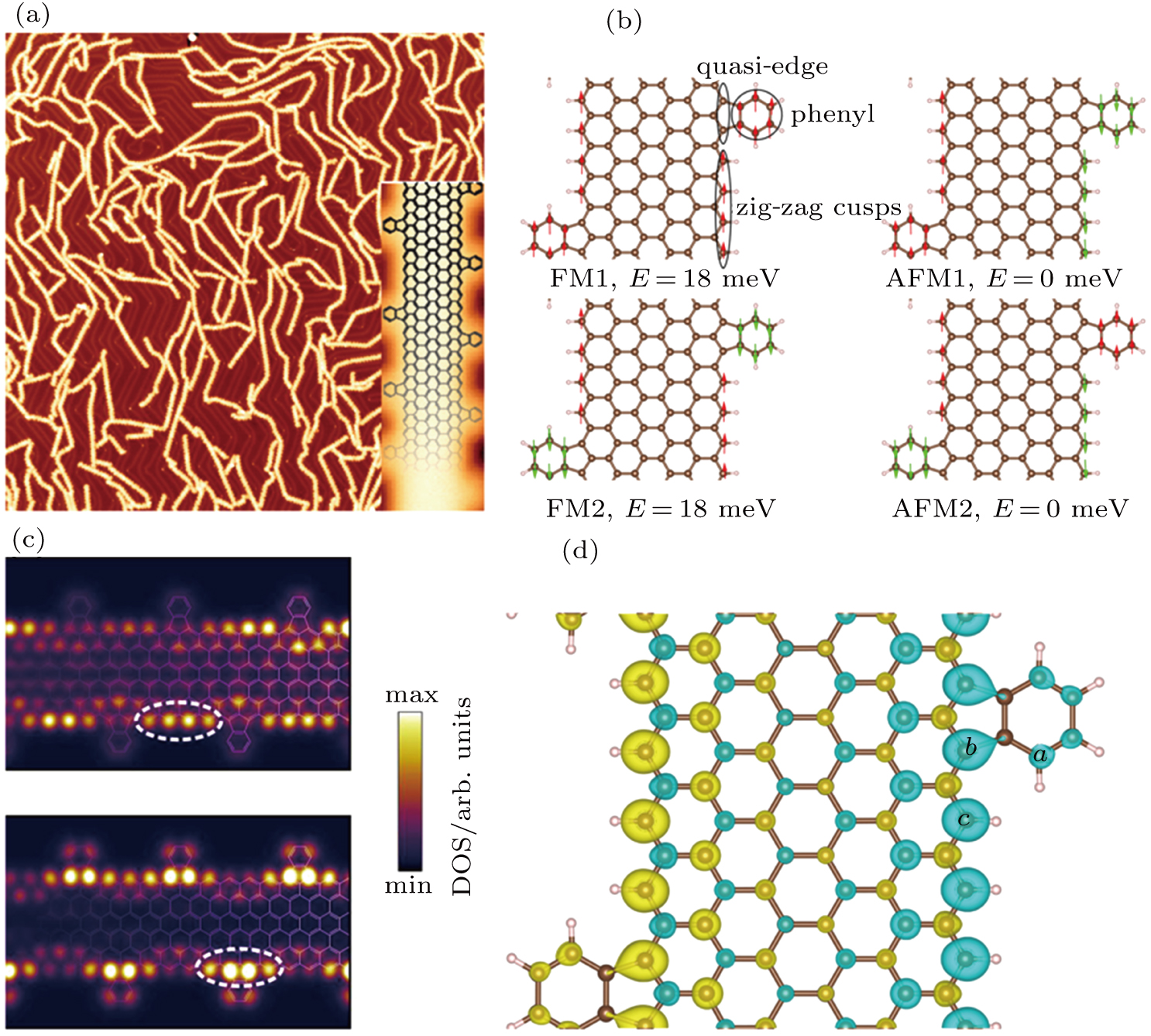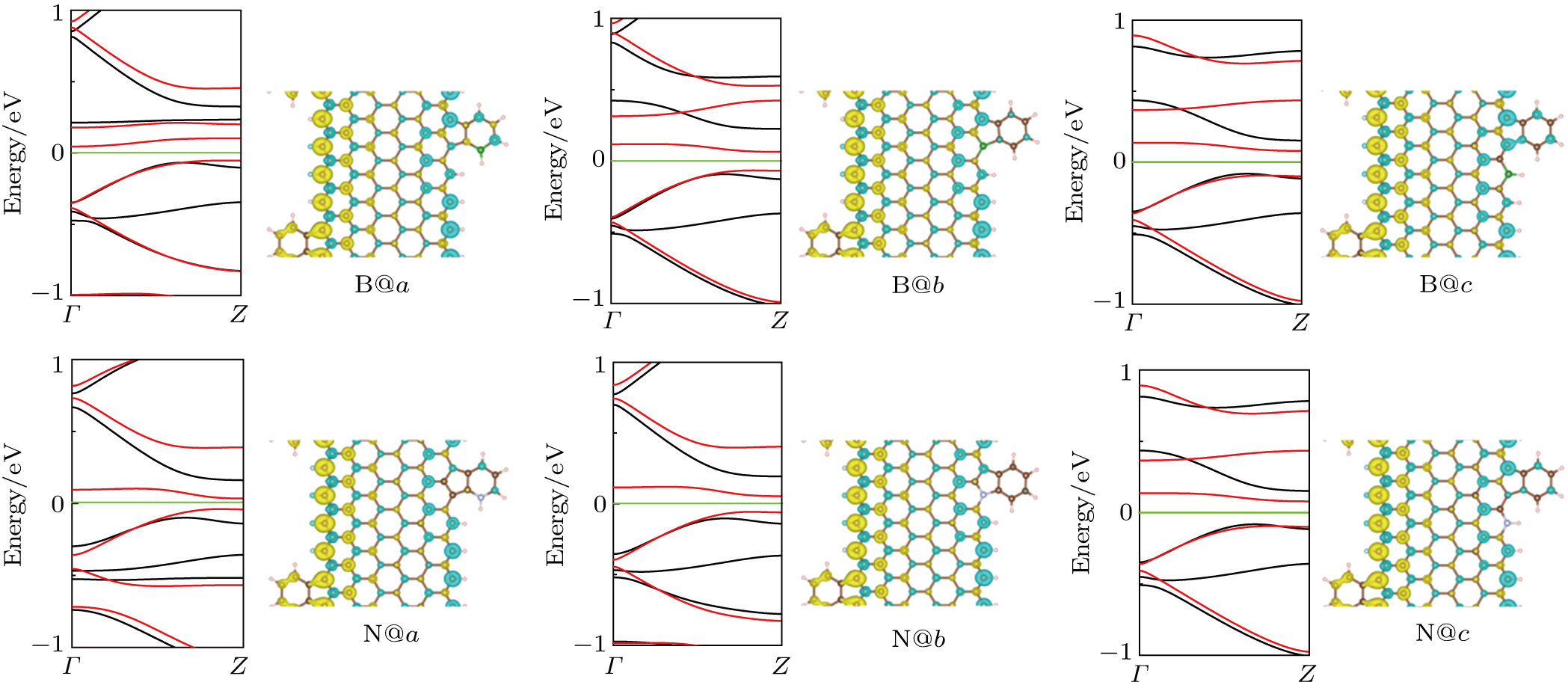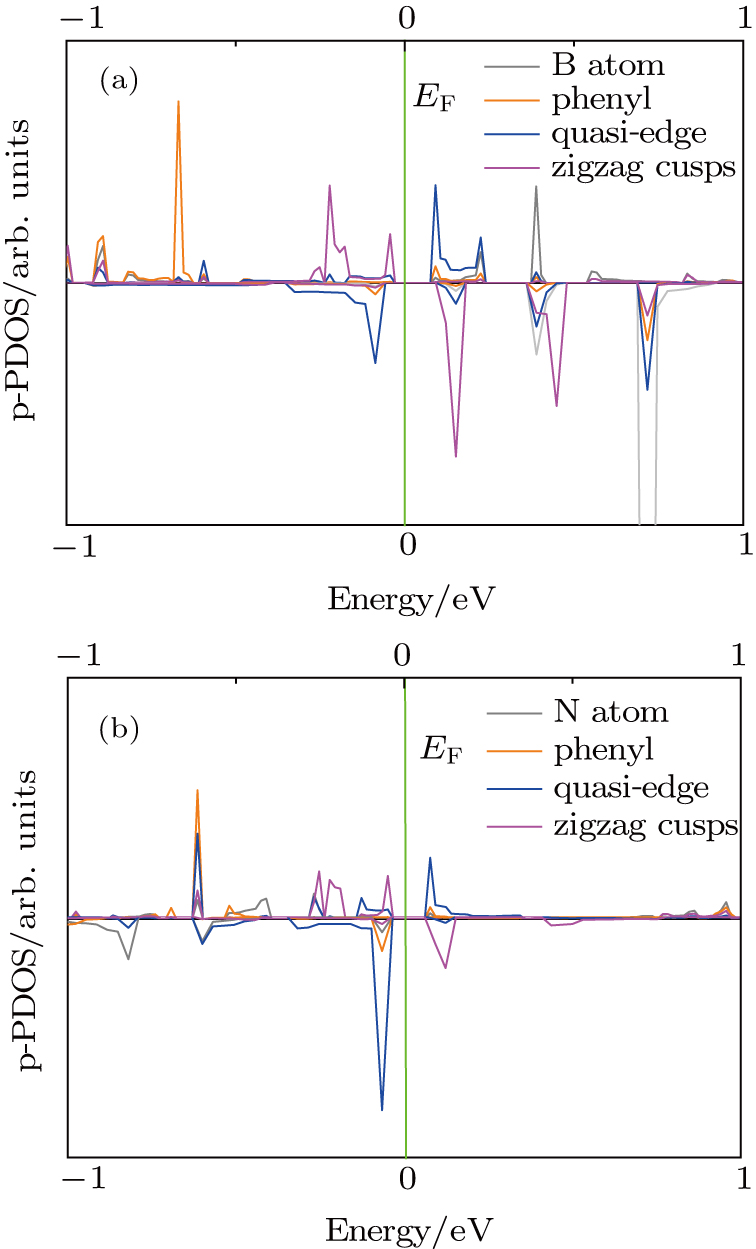† Corresponding author. E-mail:
Zigzag graphene nanoribbon (ZGNR) is a promising candidate for next-generation spintronic devices. Development of the field requires potential systems with variable and adjustable electromagnetic properties. Here we show a detailed investigation of ZGNR decorated with edge topological defects (ED-ZGNR) synthesized in laboratory by Ruffieux in 2015 [Pascal Ruffieux, Shiyong Wang, Bo Yang, et al. 2015 Nature
Since graphene nanoribbons (GNRs) opened the band gap of two-dimensional (2D) graphene in the presence of edge states, they have soon aroused enormous interest of theorists and experimentalists in the relevant research field. Compared with armchair graphene nanoribbon (AGNR), zigzag graphene nanoribbon (ZGNR) is more concentrated due to its spin polarized edge states with ferromagnetic (FM) order at the same edge but antiferromagnetic (AFM) order between the opposite edges. Such a fascinating phenomenon in magnetism makes the ZGNR particularly applied to future spintronic devices used in memory storage, magnetic sensors and high speed computing equipment.[1]
Experimentally, ZGNR with varying widths can be realized by cutting carbon nanotubes (CNTs) or graphene. However, during its preparation, ZGNR is usually susceptible to various types of defect, such as vacancies, edge, hydrogen chemisorptions and topological defects.[2–5] Such defects could often induce its electronic and magnetic properties to change significantly, which may open new routes to practical nano devices based on ZGNR. Among these defects, topological defect could be deliberately introduced for manipulating the electronic properties of ZGNR, specially, asymmetry distribution of topological defect and the strain-induced ZGNR with topological defect lying in the middle produce obvious magnetism.[6,7] Meanwhile, topological defects transformation from center to edge is accompanied by a semiconductor-to-half-metal transition;[8–10] More interestingly, introducing heteroatoms (mainly nitrogen and boron atoms) into topological defect[2] makes us manipulate the magnetism and metallicity of ZGNR simultaneously. Thus, topological defect, together with topological doping, enable us to modulate the electronic properties more elaborately.
Recently, a new type of ZGNR with edge topological defect (ED-ZGNR) has been synthesized in laboratory, and it is an intermediate product of ZGNR in on-surface synthesis process.[11] To the best of our knowledge, there is no research on ZGNR with topological defect of its edges, and we speculate such a fresh edge state under reconstruction could bring in new intriguing performance of its electric and magnetic properties. Thus, we concentrate on the ED-ZGNR system in this paper, doping it with nitrogen (N), boron(B) atoms at different positions around the edge, and compare their energy band structures and spin distribution patterns in particular. The acquired result provides a qualitative reference to the designation of inorganic magnetic materials, which widens the application scope in spintronics.
The generalized gradient approximation (GGA)[12,13] with the Perdew–Burke–Ernzerhof (PBE)[14] functional and a 500-eV cutoff for the plane-wave basis set were employed for all the density functional theory (DFT) computations with the Vienna ab initio simulation package (VASP).[15,16] The projector-augmented plane wave (PAW)[17,18] was used to model the electron–ion interaction. The Brillouin zone was sampled by 1×1×11 k-point meshes according to the Monkhorst–Pack scheme,[19] and the convergence threshold was set to be 1.0×10−5 eV in energy and 0.01 eV/Å in force. The positions of all the atoms in the unit cell were fully relaxed during the geometry optimization. On the basis of the equilibrium structure, 60 k points were used to compute band structure. To ensure the interaction between the defective ZGNRs, the vacuum of 15 Å is added both to neighboring cells and along the width direction.
The STM image of 6-ED-ZGNR (six carbon zigzag lines wide, Fig.
 | Fig. 1. (color online) (a) Overview STM image (V = −1.5 V, I = 150 pA) of 6-ED-ZGNRs fabricated on Au (111) surface with scale bar being 20 nm. Inset shows high-resolution STM image (V = 0.15 V, I = 2 pA), with scale bar being 1 nm;[11] (b) four different spin configurations on edges; (c) DFT-based density of states at E = −0.10 eV (corresponding to the highest occupied state) and E = 0.15 eV (corresponding to the lowest unoccupied level);[11] (d) spin-polarized charge density of 6-ED-ZGNR, with the spin-up and spin-down electron densities represented by the yellow and cyan colors, respectively. |
The relaxed average bond length of edge C–C is 1.41 Å. As shown in Fig.
In order to obtain precise band structure, we first identify the ground state of ED-ZGNR system. Since the perfect ZGNR is magnetically ordered, we only perform spin polarized calculations. The tested spin orientations between neighbor phenyl carbon atoms tend to be spin-consistent, so we only expect four spin configurations, which are shown in Fig.
The band structure of 6-ED-ZGNR based on AFM ground state is plotted in Fig. 

For the exploitation of spin-polarized band structure and variable electromagnetic properties, doping pristine ED-ZGNR system with N, B atoms seems achievable. Just as indicated by our conclusion above, edge atoms play dominant role in forming energy bands near the Fermi level, and the existence of energy gap is also necessary for various applications in nano-electronics. When edge atoms are substituted, spin polarization may be controlled on the basis of reserving band gaps.
We consider three typical doping positions a, b, c (Fig. 









| Table 1.
Ground states, values of formation energy |
The corresponding band structures and spin distribution patterns based on their ground states are shown in Fig.
To further investigate the origins of the spin-resolved band structures and different blocking effects on heteroatoms (N/B), we exemplify the PDOSs of the most feasible ribbons B@c and N@c in Fig.
| Table 2.
Magnetic moments of different edge components, including heteroatom (B/N), phenyl, quasi-edge, and zigzag cusps, respectively. . |
The electronic structure and magnetic properties of ZGNR decorated with edge topological defect are studied by using first-principle calculations. It is found that the pristine ED-ZGNR in the ground state is an AFM semiconductor. The edge topological defect breaks the integrity of graphene sub lattice, resulting in several flat bands in the vicinity of Fermi level, moving the positions of VBM and CBM, and causing a narrower band gap than that of the perfect ZGNR. The HOMO and LUMO are mainly provided by zigzag cusps and quasi-edge atoms in our study, which are atoms inherited from perfect ZGNR edges. After N, B atoms are doped at the different positions on the edge, both N and B atoms substituting for C atoms at zigzag cusps are the most favorable. The induced magnetic moments in doped ribbons are close to one unit per unit cell. At the same time, the pristine degenerate band structure becomes spin-split, and the breaking of degeneracy makes the doped ribbons half-semi-metals, which opens up the possibilities for spin polarized current. Both spin polarized band structure and induced magnetic moments stem from the asymmetric spin distribution caused by different blocking effects of heteroatom. Our study shows the interesting results of modulating variable and diverse properties of ZGNR, and the acquired half-semi-metals are quite promising candidates for future nanoelectronics, thereby expanding the application scope of graphene-based materials in spintronic field.
| [1] | |
| [2] | |
| [3] | |
| [4] | |
| [5] | |
| [6] | |
| [7] | |
| [8] | |
| [9] | |
| [10] | |
| [11] | |
| [12] | |
| [13] | |
| [14] | |
| [15] | |
| [16] | |
| [17] | |
| [18] | |
| [19] | |
| [20] | |
| [21] | |
| [22] | |
| [23] | |
| [24] | |
| [25] | |
| [26] | |
| [27] | |
| [28] | |
| [29] | |
| [30] |








